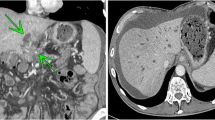Abstract
Purpose
To evaluate clinical outcomes of endoscopic ultrasound (EUS)-guided biliary drainage (EUS-BD) for unresectable malignant biliary obstruction for cases in which endoscopic retrograde cholangiopancreatography (ERCP) failed at a high-volume center.
Methods
All 99 EUS-BD cases of unresectable malignant biliary obstruction at Sendai City Medical Center between February 2007 and September 2017 were retrospectively evaluated. ERCP is strictly prioritized over EUS-BD during the study period, and EUS-BD was performed in cases wherein ERCP was impossible or ineffective. Technical success, clinical success, adverse events, and time to recurrence of biliary obstruction were evaluated.
Results
EUS-BD was technically successful in 98% of the patients (97/99). The clinical success rate was 93% (90/97). Adverse events that were definitely related to the procedure were observed in ten patients (10%; peritonitis in six, acute cholecystitis in four). Of six patients with bile peritonitis, four suffered from mild localized peritonitis that improved with conservative treatment, whereas two developed pan-peritonitis that improved with additional intervention. Other three patients with a poor performance status succumbed shortly after the successful EUS-BD, with a possible association between the procedure and death. In the 68 patients with a bilioenteric stent, the median time to recurrence of biliary obstruction was 339 days (95% confidence interval (CI), 14–664 days) during the mean follow-up period of 136 ± 173 days.
Conclusion
EUS-BD was found to be feasible. However, there were a few patients with an unfavorable course after successful EUS-BD.





Similar content being viewed by others
References
Giovannini M, Moutardier V, Pesenti C, Bories E, Lelong B, Delpero JR. Endoscopic ultrasound-guided bilioduodenal anastomosis: a new technique for biliary drainage. Endoscopy. 2001;33:898–900.
Horaguchi J, Fujita N, Noda Y, Kobayashi G, Ito K, Obana T, et al. Endosonography-guided biliary drainage in cases with difficult transpapillary endoscopic biliary drainage. Dig Endosc. 2009;21:239–44.
Yamao K, Bhatia V, Mizuno N, Sawaki A, Ishikawa H, Tajika M, et al. EUS-guided choledochoduodenostomy for palliative biliary drainage in patients with malignant biliary obstruction; results of long-term follow-up. Endoscopy. 2008;40:340–2.
Hara K, Yamao K, Niwa Y, Sawaki A, Mizuno N, Hijioka S, et al. Prospective clinical study of EUS-guided choledochoduodenostomy for malignant lower biliary tract obstruction. Am J Gastroenterol. 2011;106:1239–45.
Park DH, Jang JW, Lee SS, Seo DW, Lee SK, Kim MH. EUS-guided biliary drainage with transluminal stenting after failed ERCP: predictors of adverse events and long-term results. Gastrointest Endosc. 2011;74:1276–84.
Horaguchi J, Fujita N, Noda Y, Kobayashi G, Ito K, Koshita S, et al. Metallic stent deployment in endosonography-guided biliary drainage: long-term follow-up results in patients with bilio-enteric anastomosis. Dig Endosc. 2012;24:457–61.
Eastern Cooperative Oncology Group (1999) Common toxicity criteria, version 2.0. http://ctepcancergov/protocolDevelopment/electronic_applications/docs/ctcv20_4-30-992pdf April 30, 1999.
Sharaiha RZ, Khan MA, Kamel F, Tyberg A, Tombazzi CR, Ali B, et al. Efficacy and safety of EUS-guided biliary drainage in comparison with percutaneous biliary drainage when ERCP fails: a systematic review and meta-analysis. Gastrointest Endosc. 2017;85:904–14.
Harsha M, Bechtold ML, Forcione D, Srinivas P. A meta-analysis and systematic review: success of endoscopic ultrasound guided biliary stenting in patients with inoperable malignant biliary strictures and a failed ERCP. Medicine. 2017;96(3):e5154.
Kawakubo K, Isayama H, Kato H, Itoi T, Kawakami H, Hanada K, et al. Multicenter retrospective study of endoscopic ultrasound-guided biliary drainage for malignant biliary obstruction in Japan. J Heparobiliary Pancreat Sci. 2014;21:328–4.
Dhir V, Itoi T, Khashab M, Oark DH, Bun AY, Attam R, et al. Multicenter comparative evaluation of endoscopic placement expandable metal stent for malignant distal common bile duct obstruction by ERCP or EUS-guided approach. Gastrointest Endosc. 2014;81:913–23.
Khashab MA, Van der Merwe S, Kunda R, El Zein MH, Teoh AY, Marson FP, et al. Prospective international multicenter study on endoscopic ultrasound-guided biliary drainage for patients with malignant distal biliary obstruction after failed endoscopic retrograde cholangiopancreatography. Endosc Int Open. 2016;4:E487–96.
Kanno Y, Ito K, Koshita S, Ogawa T, Masu K, Masaki Y, et al. Efficacy of a newly developed dilator for endoscopic ultrasound-guided biliary drainage. World J Gastrointest Endosc. 2017;16:304–9.
Binmoeller KB, Shah J. A novel lumen-apposing stent for transluminal drainage of nonadherent extraintestinal fluid collections. Endoscopy. 2011;43:337–42.
Itoi T, Binmoeller KB, Shah J, Sofuni A, Itokawa F, Kurihara T, et al. Clinical evaluation of a novel lumen-apposing metal stent for endosonography-guided pancreatic pseutocyst and gallbladder drainage (with video). Gastrointest Endosc. 2012;75:870–6.
Tsuchiya T, Teoh AYB, Itoi T, Yamao K, Hara K, Nakai Y, Isayama H, Kitano M (2017) Long-term outcomes of EUS-guided choledochoduodenostomy using a lumen-apposing metal stent for malignant distal biliary obstruction: a prospective multicenter study. Gastrointest Endosc
Funding
This study received no specific grant from any funding agency in the public, commercial, or not-for-profit sectors.
Author information
Authors and Affiliations
Contributions
All authors had access to the study data and reviewed and approved the final manuscript.
Corresponding author
Ethics declarations
Both the EUS-BD procedure and this study were approved by the Institutional Review Board of Sendai City Medical Center. Written informed consent for EUS-BD was obtained with presenting risks and benefits in comparison with other possible options from all patients before the procedure.
Conflict of Interest
The authors declare that they have no conflicts of interest.
Rights and permissions
About this article
Cite this article
Kanno, Y., Koshita, S., Ogawa, T. et al. EUS-Guided Biliary Drainage for Unresectable Malignant Biliary Obstruction: 10-Year Experience of 99 Cases at a Single Center. J Gastrointest Canc 50, 469–477 (2019). https://doi.org/10.1007/s12029-018-0096-1
Published:
Issue Date:
DOI: https://doi.org/10.1007/s12029-018-0096-1




